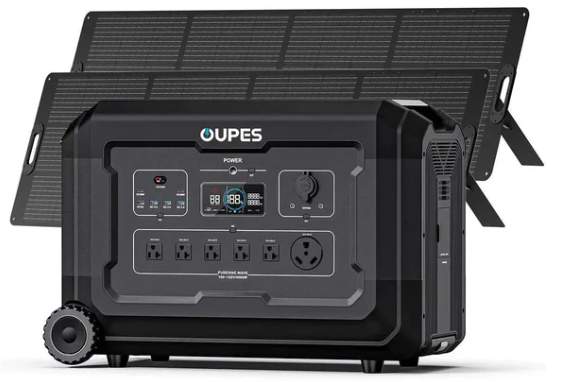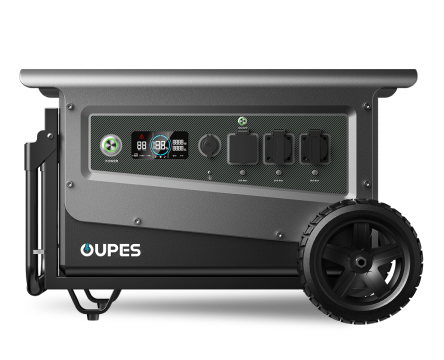
Table of Contents
- Understanding Surge Current
- Why Surge Current Matters
- How Surge Current Affects Appliances
- Surge Current vs Rated Current
- How Portable Solar Generators Handle Surge Current
- Managing and Preventing Surge Damage
- Practical Surge Current Examples
- FAQ
Understanding Surge Current
Surge current, also known as inrush current, refers to the sudden burst of electrical current that flows into a device when it’s first powered on. This spike is typically much higher than the device’s regular operating (rated) current and lasts for a short duration — usually milliseconds to a few seconds. According to the National Renewable Energy Laboratory (NREL), surge currents can be 2–10 times greater than the steady-state current, depending on the appliance type.
For example, when you turn on a refrigerator, its compressor motor requires a strong initial current to overcome inertia and start running. That initial burst — the surge current — quickly settles down to normal levels once the motor stabilizes.
Why Surge Current Matters
1. Impact on Electrical Systems
Surge currents are not inherently harmful, but if not properly managed, they can cause issues such as:
- Tripped circuit breakers or blown fuses
- Overheating of wiring or components
- Reduced lifespan of sensitive electronics
- Temporary voltage drops in small-scale systems
2. Significance for Off-Grid and Solar Power Users
When using portable solar generators or power stations, surge current plays a major role in determining compatibility. If a generator cannot handle a device’s surge requirement, it may shut down or trigger overload protection. For off-grid users relying on limited battery capacity, understanding surge current ensures they choose a system that supports all connected devices effectively.
How Surge Current Affects Appliances
1. Inductive Loads (Motors, Pumps, Compressors)
Appliances with electric motors — such as air conditioners, refrigerators, or power tools — experience the highest surge currents. When first powered on, their magnetic fields must build up rapidly, causing a temporary spike in current.
2. Resistive Loads (Heaters, Lights)
Devices like electric heaters and incandescent bulbs have minimal surge current since their electrical resistance limits the flow from the start. However, LED lights and electronic drivers can experience moderate surges due to internal capacitors.
3. Electronic Loads (Computers, TVs, Chargers)
These contain switching power supplies that draw higher current for a fraction of a second during startup to charge internal capacitors. While the duration is brief, inadequate surge protection can damage power circuits or trigger shutdowns.
Surge Current vs Rated Current
Understanding the difference between surge current and rated current is essential when choosing the right power source or solar generator.
| Parameter | Surge Current | Rated Current |
|---|---|---|
| Definition | Maximum short-term current drawn when the device starts up | Continuous current required for steady operation |
| Duration | Milliseconds to a few seconds | Continuous during operation |
| Magnitude | 2–10× higher than rated current | Stable and consistent |
| Example (Refrigerator) | 600W surge at startup | 150W continuous |
| Generator Requirement | Must handle surge capacity | Determines overall runtime |
Key Takeaway:
When sizing a solar generator, always check its rated output power and surge (peak) power rating. For instance, if your refrigerator requires 150W running power but surges to 600W, your power station must support at least 600W of surge output.
How Portable Solar Generators Handle Surge Current
1. Built-in Inverters with Surge Capability
Solar generators and power stations convert DC battery energy into AC power through inverters. High-quality inverters include surge protection circuits that can deliver a temporary power boost — often 1.5–2× their rated output — for devices requiring higher startup current. For example, a 1000W generator with a 2000W surge rating can safely power appliances like refrigerators or blenders.
2. Battery Chemistry and Performance
Battery type influences how well a system manages surges. Lithium iron phosphate (LiFePO₄) batteries — such as those used in OUPES portable power stations — deliver stable high current without voltage drops or overheating. This makes them superior to older lead-acid or lithium-ion batteries for surge-heavy applications.
3. Smart Battery Management Systems (BMS)
Modern power stations use intelligent BMS software that regulates voltage, temperature, and current flow. During surge events, it prevents battery stress while maintaining power delivery — ensuring safe and consistent performance over thousands of cycles.
Managing and Preventing Surge Damage
1. Use Devices with Soft-Start Technology
Soft-start circuits gradually ramp up voltage and current when appliances turn on, reducing surge stress. This feature is common in energy-efficient refrigerators, compressors, and air conditioners.
2. Prioritize Surge Protection Devices
A surge protector or Uninterruptible Power Supply (UPS) adds another layer of defense for sensitive electronics. These devices absorb excess voltage and prevent it from reaching your appliances or generator.
3. Avoid Overloading the Generator
Exceeding the rated or surge power capacity of your portable generator may trigger automatic shutdown. Always keep the total load below 80% of the rated output for continuous, safe operation.
4. Stagger Appliance Startups
Turn on high-power devices one at a time to prevent simultaneous surges that could overload the inverter. This simple method extends the lifespan of your power station and connected electronics.
Practical Surge Current Examples
1. Common Household Devices and Their Power Ratings
| Device | Rated Power (W) | Surge Power (W) | Surge Ratio |
|---|---|---|---|
| Mini Refrigerator | 150 | 600 | 4× |
| Microwave Oven | 1000 | 1500 | 1.5× |
| Air Conditioner (Small Unit) | 1200 | 2500 | 2× |
| Drill or Power Tool | 800 | 1600 | 2× |
| Laptop | 60 | 90 | 1.5× |
2. Solar Generator Selection Example
If your total daily usage is around 800W with a potential surge load of 1500W, you should select a power station rated at 1000W continuous and 2000W surge capacity. This ensures smooth startup and stable performance without overloads.
3. Seasonal and Environmental Considerations
Surge demand can vary with temperature and usage conditions. For example, during winter, electric heaters may require higher startup power, while in summer, refrigerators and air conditioners surge more frequently. Planning with headroom ensures your system handles fluctuations efficiently.
FAQ
1. How long does surge current last?
Typically, surge current lasts from a few milliseconds to two seconds, depending on the type of device. Motors and compressors experience the longest surges.
2. Why do appliances need surge current?
Surge current helps overcome initial resistance, inertia, or magnetic field buildup required for devices like motors or compressors to start functioning properly.
3. Can surge current damage my solar generator?
Only if the device’s surge exceeds the generator’s rated peak power. High-quality generators like OUPES units have built-in protection to manage short surges safely.
4. How do I calculate total surge load?
Add up the surge wattage of all devices you plan to power simultaneously. Compare it with your generator’s surge rating to ensure sufficient capacity.
5. What’s the difference between surge watts and continuous watts?
Surge watts represent short-term peak output, while continuous watts reflect sustained operating capacity. Both ratings are crucial when sizing power systems.
Conclusion
Understanding surge current is essential for managing household and off-grid power systems effectively. Whether you’re using a traditional home setup or a portable solar generator, recognizing how surge currents work helps prevent overloads, optimize performance, and extend equipment lifespan. By investing in reliable, surge-capable systems like OUPES power stations and following safe energy practices, you can ensure stable, sustainable power — no matter where you are.




























